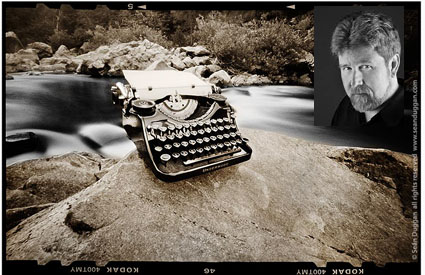 .
..
Sean Duggan
Seán Duggan is a fine art photographer, author, and educator. He is a co-author of Real World Digital Photography and The Creative Digital Darkroom, and he writes for Photoshop User magazine. Equally at home with both low-tech and hi-tech approaches, his visual tool kit includes a wide range of imaging tools, including wooden pinhole and plastic toy cameras that use medium format film, an Apple iPhone, full-frame digital SLRs, and advanced digital darkroom techniques.
Through his writing and teaching, he has been helping photographers master digital photography and digital darkroom techniques since 1997. His core philosophy is to help people see the image possibilities in any situation, to look for the extraordinary in the ordinary, and to seek out uniquely personal ways of interpreting a scene, both with the camera and in the digital darkroom. He leads workshops at venues across the country and he also offers customized consulting and training in northern California and online consulting sessions on digital photography, Photoshop, Lightroom, and digital workflow issues.
What’s the best thing about photography?
It provides a window through which we can view our own world, as well as the world beyond our experience, other realities and other visions.
What’s the worst thing about photography?
That there so much of it. Our culture is so inundated with photographs that they can become the visual equivalent of background noise
What’s the thing that interests you most about photography?
It takes me to other places, both real and imagined, and through it I can share ideas, stories, and experiences.
What’s the thing that interests you most about your own photographs?
My photography is a form of creative play as well as a way to explore themes and concepts that are both personal and universal. I love to find meaning in images through visual metaphors.
What’s the thing that interests you most about other people’s photographs?
The way they see and interpret their world. Their unique visions show me things I could not imagine, and present new conceptual pathways to follow.
Who were your early photographic influences?
In no particular order, and for a variety of reasons…. Jerry Uelsmann, Jan Saudek, Richard Avedon (specifically, In the American West), Joyce Tenneson, Sally Mann, Ted Orland, David Hockney, Duane Michaels, Keith Carter.
Who are your photographic influences now?
Keith Carter, Robert and Shana ParkeHarrison, Jerry Uelsmann, Nick Brandt, Rocky Schenk, Murray Fredericks.
What were your early non-photographic influences?
The natural world, poetry, theater, literature.
What’s the best thing about gear ?
The creative possibilities it offers.
What’s the worst thing about gear ?
Getting distracted by the gear and the technical process, and losing focus on the creative vision.
What’s the most useful photographic mantra?
Always look for the photograph, even when you don’t have a camera.
Do you practice another art form? (If so, which?)
Poetry, writing, creating sculptural assemblages.
What benefits do you get from (this/these) other art form/s?
Poetry helps me to be visually sensitive to the possibility of metaphor in an image; it helps me appreciate photographs as visual poems.
Writing helps me to more fully explore and understand ideas and concepts.
Making sculptural assemblages is a tactile and three-dimensional way to explore ideas through the combination of different materials and found objects. This work often directly influences my “Artifacts of an Uncertain Origin” series of photographs.
What failure did you learn the most from?
No particular failure, but the general idea that in any failure there is an opportunity to learn something, to take that knowledge, start again, and do it better.
What accomplishment are you most proud of?
Being a good husband and a good father.
If you had another life to live a completely different life, what would you choose to do?
Four possibilities: a filmmaker, a novelist, a wilderness explorer, ex-patriot artist in a succession of cool European cities.
What’s photography really all about?
There are many answers, just as there are many photographers. For me, it is about creative exploration, sharing what I see, and fixing a small moment in time for future contemplation.
How did photography change the world?
It provided the ability to freeze a moment in the river of time and to see beyond the limits of our natural vision to witness things that are too fast, too slow, too small, or too vast for normal human perception.
How did photography change your world?
It helped me to see differently and more clearly, both through my own lens and the lenses of others.
Who were the most important photographers?
The most important photographers are the ones who inspire you.
What’s the best thing about our times?
Technology, and the potential it has to transform our lives and our world.
What’s the worst thing about our times?
Technology, and the potential it has to transform our lives and our world.
What keeps you up at night?
Too many ideas, too little time!
What gets you going in the morning?
I want to see what happens next.
What is your favorite journey?
Discovering and exploring interesting places.
How would you like to die?
Aware of the process, at peace with the eventuality, and hopefully, in no pain.
.

